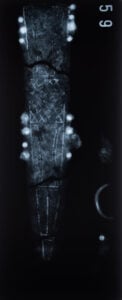Between the middle of the century and the beginning of the second century, the Roman legionaries clashed with Germanic fighters near the Danube river in a furious battle. Almost two thousand years later, horrible evidence of the bloody event have been revealed.
When renovating a sports field in Vienna in October from last year, construction workers discovered a mass grave. Experts from the Archeology Department of the City of Vienna and the Provider of Archaeological Services November GmbH revealed that human remains probably belonged to deceased soldiers during a battle involving former Roman legionaries. The discovery and analysis are detailed in a declaration from the Wien museum published on Wednesday.
“In Vienna, we are always ready to meet Roman traces as soon as we open a sidewalk or opens the land: after all, Vindobona threw the foundation stone of our city,” said Veronica Kaup-Hasler, the executive councilor of Vienna for culture and science. Vindobona was the former Roman military camp and the colony that would one day become Vienna. “A real feeling in this regard is the discovery of a tomb of Roman mass in simmering (a district of Vienna). This unique testimony allows us to look at the beginnings of the history of our city under a different perspective.”
The grave of mass includes a jumble of human remains belonging to around 150 individuals. According to initial surveys, they were all men mainly between 20 and 30 years old and showed little evidence of infectious diseases. Experts have also remarkably noted good dental health. While dentists would have been proud, the strong teeth did not save them from the wounds suffered by the daggers, the spears, the swords, the projectiles and other kinds of weapons, which proved to be their cause of death.

“Based on the arrangement of skeletons and the fact that they are all male remains, it may be excluded that the site was connected to a hospital or similar establishments, or that an epidemic was the cause of death. Bone injuries are clearly attributable to combat,” said Michaela Binder, senior anthropologist at November GmbH.
As if the injuries were not enough evidence, they also uncovered armor scales, spear tips, a piece of helmet cheek, shoe nails and a fragmented iron dagger. The dagger has proven to be particularly useful to date the remains. The x -ray images of the sheath revealed typical ancient Roman decorations: silver wire inlays that clearly date the dagger between the middle of the century and the beginning of the second century of the ECT, explained Christoph Öllerer, deputy chief of the archeology department of the city of Vienna. These dates highlight how rare this discovery is.
“Since the cremations were common in the European parts of the Roman Empire around 100 AD (CE), burials are an absolute exception. The discoveries of Roman skeletons of this period are therefore extremely rare,” said Kristina Adler-Wölfl, head of the Archeology Department of Vienna City.
The discovery is also significant at the local level, because it represents the first direct archaeological proof of a battle along the limes of the Danube, which constituted part of the eastern border of the Roman Empire. The rule of the Emperor Domitian from 81 to 96 this saw battles between the Roman legionaries and the Germanic tribes along the border of the Empire, which probably prompted the Emperor Trajan to extend the limes of the Danube little later. Until now, these conflicts had only been testified by historical sources, according to the press release.
The battle that took place thousands of years ago “could therefore have been a reason for the expansion of the formerly small military base in the Vindobona legionary camp – less than seven kilometers (4.35 miles) of the site,” explained Martin Mosser, an archaeologist from the city’s archeology department. The observation “can thus reveal the beginning of urban history of Vienna”.


